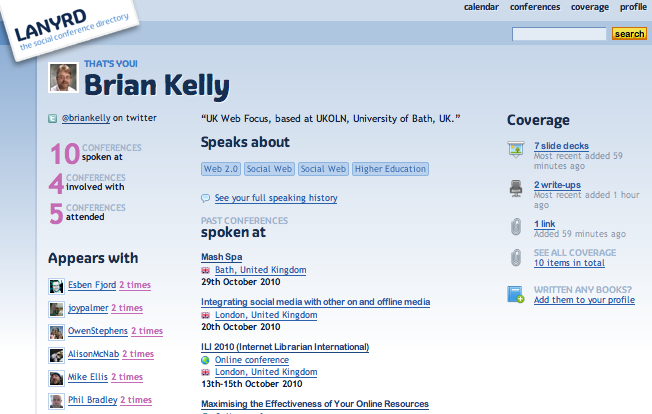Developments to the Lanyrd Service
Posted by Brian Kelly on 3 Nov 2010
The Lanyrd service was launched on 31 August and, as described on the Zeldman.com blog: “Lanyrd uses Twitter to tell you which conferences, workshops and such your friends are attending or speaking at. You can add and track events, and soon you’ll be able to export your events as iCal or into your Google calendar (the site is powered by microformats).“. The post went on to add that “Soon, too, you’ll be able to add sessions, slides, and videos“.
Yesterday there was the confirmation of Slides, video, audio, sketchnotes… coverage on Lanyrd. This announcement was accompanied by a reference of the importance which the service places on metadata: “It’s the perfect past-time for metadata addicts like us! … Make sure to add topics and speakers to the sessions. Coverage is deeply integrated with Lanyrd, and shows up in all sorts of places when combined with the right metadata.”
In order to explore how this metadata is used I created the following search queries:
- Conferences in Sheffield containing the string “UKOLN”: see results
- Conferences about “Web standards” containing the string “web”: see results
- Conferences about HTML5 containing the string “standards” held in 2010: see results
- Conferences in London containing the string “metadata”: see results
The final example has a link to a two-day event on “Maximising the Effectiveness of Your Online Resources” which I co-facilitated. At that event myself and George Munroe described various approaches which can be used to maximise awareness of and use of digital resources. Such approaches included various Search Engine Optimisation (SEO) techniques, use of metadata and exploitation of the Social Web services.
Such approaches can apply to exploitation of services such as Lanyrd (and related popular Social Web services such as YouTube, Slideshare, etc). These services are often very popular, with links to the services helping to enhance its Google ranking – and similarly links from such services can enhance traffic to institutional services. So adding your metadata and appropriate links can be a way of raising the visibility of your resources – and arguably could be more cost effective than adding such metadata only to in-house services (it should be noted that such services are often very easy to use).
I’ve registered for an account on this service, in part to monitor how this service develops and to claim my preferred username on the service – and in addition because I feel that use of such services can be beneficial and worth a little amount of time in registering and uploading a small number of items. I will also be interested to see if Lanyrd develops so that it could be used as a mainstream event Web site. As I asked recently Should Event Web Sites Be The First To Be Outsourced?. And, if so, what role could Lanyrd play?





Weeknote 04 « steve boneham's blog said
[…] Lanyrd is a relatively new, but increasingly popular service that offers some useful features for those how present at and attend conferences. This started as being mainly about ‘what’s on & who’s going?’ but now allows for event ‘coverage’ in the form of embedded slides, photos, audio and video. As I’m only just getting started with this, I’ll simply point you at the thoughts of Matt Jukes, Graham Attwell and Brian Kelly. […]
Mark Greenfield - Higher Education Web Consulting » The Axe Man Commeth Preview #higheredlive said
[…] Developments to the Lanyrd Service […]
Rediscovering Missing Conference Web Sites « UK Web Focus said
[…] and launched in 2010“. In November 2010, shortly after Lanyrd’s launch I described Developments to the Lanyrd Service and gave some Further Thoughts on Lanyrd. In May 2012 I asked Why Would You Not Use #Lanyrd For […]
An Exemplar Use of Lanyrd (and a Proposal for Creating Lanyrd Entries) « UK Web Focus said
[…] in November 2010 I write a post on Developments to the Lanyrd Service two months after the service had been launched. I described how commentators had described the […]